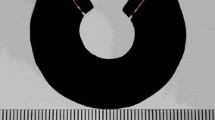Abstract
The electrical characteristics of tissue yield valuable information for early diagnosis of pathological changes. Magneto-acoustic imaging is a functional approach for imaging of electrical conductivity. This study proposes a continuous-wave magneto-acoustic imaging method. A kHz-range continuous signal with an amplitude range of several volts is used to excite the magneto-acoustic signal and improve the signal-to-noise ratio. The magneto-acoustic signal amplitude and phase are measured to locate the acoustic source via lock-in technology. An optimisation algorithm incorporating nonlinear equations is used to reconstruct the magneto-acoustic source distribution based on the measured amplitude and phase at various frequencies. Validation simulations and experiments were performed in pork samples. The experimental and simulation results agreed well. While the excitation current was reduced to 10 mA, the acoustic signal magnitude increased up to 10−7 Pa. Experimental reconstruction of the pork tissue showed that the image resolution reached mm levels when the excitation signal was in the kHz range. The signal-to-noise ratio of the detected magneto-acoustic signal was improved by more than 25 dB at 5 kHz when compared to classical 1 MHz pulse excitation. The results reported here will aid further research into magneto-acoustic generation mechanisms and internal tissue conductivity imaging.











Similar content being viewed by others
References
Aliroteh MS, Scott G, Arbabian A (2014) A frequency-modulated magneto-acoustic detection and imaging. Electron Lett 50(11):790–792
Craig EC (1993) Electronics via waveform analysis. Springer, New York, pp 315–317
Emerson JF, Chang DB, McNaughton S, Jeong JS, Shung KK, Cerwin SA (2013) Electromagnetic acoustic imaging. IEEE Trans Ultrason Ferroelectron 60(2):364–372
Guoqiang L, Xin H, Hui H (2013) Magnetoacoustic tomography with current injection. Chin Sci Bull 58(30):3600–3606
Hu G, He B (2011) Magnetoacoustic imaging of electrical conductivity of biological tissues at a spatial resolution better than 2 mm. PLoS One 6(8):e23421
Hu G, Cressman E, He B (2011) Magnetoacoustic imaging of human liver tumor with magnetic induction. Appl Phys Lett 98:023703
Li X, He B (2010) Multi-excitation magnetoacoustic tomography with magnetic induction (MAT-MI). Int Conf Electr Bioimpedance. 224:012035
Mariappan L, Hu G, He B (2014) Magnetoacoustic tomography with magnetic induction for high-resolution bioimepedance imaging through vector source reconstruction under the static field of MRI magnet. Med Phys 41:022902
Mohamad Salim MI, Supriyanto E, Haueisen J, Ariffin I, Ahmad AH, Rosidi B (2013) Measurement of bioelectric and acoustic profile of breast tissue using hybrid magnetoacoustic method for cancer detection. Med Biol Eng Comput 51(4):459–466
Mongrain G, Destrempes F, Mari JM, Souchon R, Catheline S, Chapelon JY, Cloutier G (2015) Acousto-electrical speckle pattern in Lorentz force electrical impedance tomography. Phys Med Biol 60:3747–3757
Montalibet A, Jossinet J, Matias A (2001) Electric current generated by ultrasonically induced Lorentz force in biological media. Med Biol Eng Comput 39(1):15–20
Narayana N (2006) Elements of engineering electromagnetics. China Machine Press, Beijing, pp 35–37
Oppenheim A, Wliisky AS, Nawab H (1998) Signals and systems. Xian jiaotong university press & Prentice Hall, New York, pp 371–392
Powell MJD (1970) A new algorithm for unconstrained optimisation. Academic Press Inc, New York, pp 31–66
Renzhiglova E, Ivantsiv V, Xu Y (2010) Difference frequency magneto-acousto-electrical tomography (DF-MAET) application of ultrasound-induced radiation force to imaging electrical current density. IEEE Trans Ultrason Ferroelectron 57(11):2319–2402
Roth BJ (2011) The role of magnetic forces in biology and medicine. B Exp Biol Med 236:132–137
Roth BJ, Basser PJ, John PW (1994) A theoretical model for magneto-acoustic imaging of bioelectric currents. IEEE Trans Bio-Med Eng 41(8):723–728
Roth BJ, Luterek A, Puwal S (2014) The movement of a nerve in a magnetic field: application to MRI Lorentz effect imaging. Med Biol Eng Comput 52(5):491–498
Scofield JH (1994) Frequency-domain description of a lock-in amplifier. Am J Phys 62(2):129–132
Shigang W, Shunqi Z, Ren M, Tao Y, Zhipeng L (2014) A study of acoustic source generation mechanism of Magnetoacoustic Tomography. Comput Med Imaging Graph 38(1):42–48
Sun Xiaodong, Zhang Feng, Ma Qingyu, Juan Tu, Zhang Dong (2012) Acoustic dipole radiation based conductivity image reconstruction for magnetoacoustic tomography with magnetic induction. Appl Phys Lett 100:024105
Towe BC, Islam MR (1988) A magneto-acoustic method for the noninvasive measurement of bioelectric currents. IEEE Trans Bio-Med Eng 35(10):892–894
Tseng Nancy, Roth Bradley J (2008) The potential induced in anisotropic tissue by the ultrasonically-induced Lorentz force. Med Biol Eng Comput 46(2):195–197
Wen H, Shah J, Balaban RS (1998) Hall Effect imaging. IEEE Trans Bio-Med Eng 45(1):119–124
Xiao-Dong S, Xin W, Yu-Qi Z, Qing-Yu M, Dong Z (2015) Reception pattern influence on magnetoacoustic tomography with magnetic induction. Chin Phys B 24(1):014302
Xu Y, He B (2005) Magnetoacoustic tomography with magnetic induction (MAT-MI). Phys Med Biol 50:5175–5187
Acknowledgments
This work was supported in part by the National Natural Fund of China (#81171424, #51137004, #61501523) and the Tianjin Youth Fund in Basic Research on Application (#13JCQNJC14000).
Author information
Authors and Affiliations
Corresponding author
Rights and permissions
About this article
Cite this article
Shunqi, Z., Zhou, X., Tao, Y. et al. Magneto-acoustic imaging by continuous-wave excitation. Med Biol Eng Comput 55, 595–607 (2017). https://doi.org/10.1007/s11517-016-1538-1
Received:
Accepted:
Published:
Issue Date:
DOI: https://doi.org/10.1007/s11517-016-1538-1




